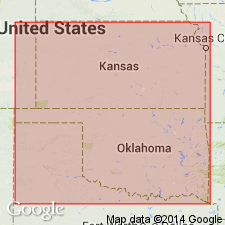
- Usage in publication:
-
- Americus limestone
- Modifications:
-
- Original reference
- Dominant lithology:
-
- Limestone
- AAPG geologic province:
-
- Forest City basin
Summary:
Pg. 80. Americus limestone. Two layers of limestone (upper one thin and bluish, lower one light buff and 16 inches thick) separated by 4 feet of shale. Separated from overlying Dunlap [Neva] limestone by 50 feet of shale and from underlying Emporia limestone by an extensive shale bed. Age not stated. Report includes cross section.
Named from exposures near Americus, Lyon Co., eastern KS.
Source: US geologic names lexicon (USGS Bull. 896, p. 45); supplemental information from GNU records (USGS DDS-6; Denver GNULEX).
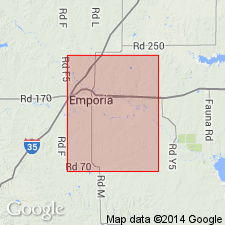
- Usage in publication:
-
- Americus limestone
- Modifications:
-
- Revised
- AAPG geologic province:
-
- Forest City basin
Summary:
Pg. 703-737. Americus limestone. Consists of (descending): limestone, 6 inches; shale, 6 feet; solid buff limestone 21 inches. Is overlain by Elmdale formation and underlain by sandy shales which are to be named by Adams. Age is late Paleozoic. Has been mapped across Lyon County, eastern Kansas.
Source: US geologic names lexicon (USGS Bull. 896, p. 45); supplemental information from GNU records (USGS DDS-6; Denver GNULEX).
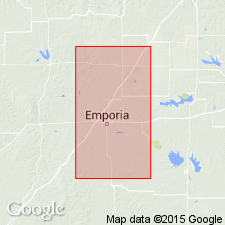
- Usage in publication:
-
- Americus limestone system
- Modifications:
-
- Revised
- AAPG geologic province:
-
- Forest City basin
Summary:
(A bulletin on Lyon County geology, McCord and McCord Printers). Americus limestone system. Consists of (descending): (1) flag limestone, 6 inches; (2) shale, 6 feet; (3) good building stone containing many FUSULINA, 21 inches (limestone known as Americus limestone and quarried near village of Americus; color neutral drab; weathers light buff; texture even, compact, and semicrystalline); (4) shale, 8 feet; (5) limestone, 1 foot; weathers to dry bone formation. Rests on 45 feet of shale containing red sandstone in places, and is overlain by 8 to 26 feet of black, blue, and buff shale. Age is Pennsylvanian.
[See also A.J. Smith, 1901, Kansas Acad. Sci. Trans., v. 17, p. 189-193 (available online through the Biodiversity Heritage Library: http://biodiversitylibrary.org/page/11873295, accessed November 11, 2010); A.J. Smith, 1903, Kansas Acad. Sci. Trans., v. 18, p. 99-103 (available online through the Biodiversity Heritage Library: http://biodiversitylibrary.org/page/8596387, accessed November 11, 2010).]
Source: US geologic names lexicon (USGS Bull. 896, p. 45).
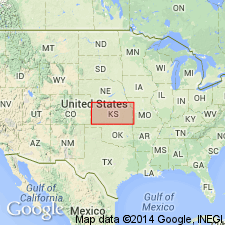
- Usage in publication:
-
- Americus limestone*
- Modifications:
-
- Revised
- AAPG geologic province:
-
- Forest City basin
Summary:
Americus limestone. In Lyon County, eastern Kansas, underlies Elmdale formation and overlies Admire shales (new). Thickness 5 feet. Consists of (descending) (1) limestone, (2) thin shale, and (3) limestone, 16 inches thick. Age is late Carboniferous. [Report includes fossil list.]
Source: US geologic names lexicon (USGS Bull. 896, p. 45); supplemental information from GNU records (USGS DDS-6; Denver GNULEX).
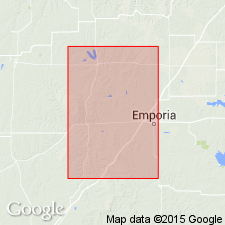
- Usage in publication:
-
- Americus beds
- Modifications:
-
- Revised
- AAPG geologic province:
-
- Forest City basin
Summary:
Americus beds, 155 feet thick, consist of Americus limestone and shales (above), 35 feet thick, and Admire shales and limestones (below), 120 feet thick. Underlie Elmdale beds and overlie Emporia beds. Age is Pennsylvanian.
Source: US geologic names lexicon (USGS Bull. 896, p. 45).
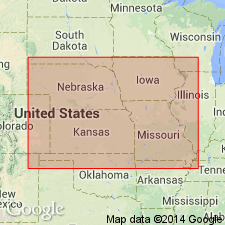
- Usage in publication:
-
- Americus limestone
- Modifications:
-
- Overview
Summary:
Americus limestone, 8 feet thick, is quarried at Americus. Underlies Elmdale formation and overlies Admire formation. Age is Pennsylvanian.
Source: US geologic names lexicon (USGS Bull. 896, p. 45).
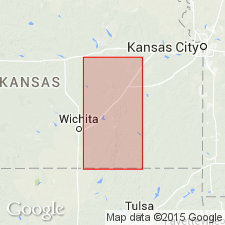
- Usage in publication:
-
- Americus limestone
- Modifications:
-
- Overview
Summary:
Americus limestone, 8 feet thick, is a rather persistent limestone, which on outcrop breaks into large blocks which are strewn down slope beneath. Underlies Elmdale shale and overlies Admire shale. Age is Pennsylvanian.
Source: US geologic names lexicon (USGS Bull. 896, p. 45).
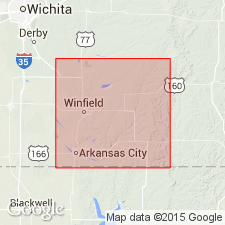
- Usage in publication:
-
- Americus(?) limestone member
- Modifications:
-
- Revised
- Areal extent
- AAPG geologic province:
-
- Nemaha anticline
Summary:
Pg. 45. Americus(?) limestone member of Foraker limestone. Divided the beds in Cowley County, eastern Kansas, between Neva limestone above and Admire shale below into (descending) Elmdale shale restricted (80 feet thick) and Foraker limestone (47 to 50 feet thick), the latter including at base a limestone, 2.5 to 4 feet thick, designated as Americus(?) limestone member. Age is Pennsylvanian.
Source: US geologic names lexicon (USGS Bull. 896, p. 45).
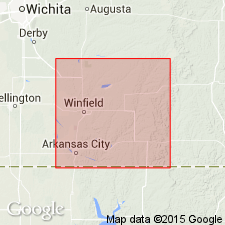
- Usage in publication:
-
- Americus limestone member
- Modifications:
-
- Revised
- Areal extent
- AAPG geologic province:
-
- Forest City basin
- Nemaha anticline
Summary:
Pg. 45, footnote. Americus limestone member of Foraker limestone. Recent field work by G.E. Condra and me has shown definitely that Americus limestone of type locality extends southward and constitutes basal part of the Foraker as described by Bass (Cowley Co. Rpt. Bull. 12 above cited) and by Heald [?] and others in Osage County, Oklahoma. [In footnote on p. 50 Moore states:] It Is likely detailed stratigraphic work will
afford basis for definite determination of relations of type Foraker to Americus and Elmdale.
Source: US geologic names lexicon (USGS Bull. 896, p. 45).

- Usage in publication:
-
- Americus limestone member
- Modifications:
-
- Age modified
Summary:
Americus limestone member of Foraker limestone of Council Grove group. Transferred this limestone to Permian (Big Blue series) and showed it as basal member of Foraker limestone, and as consisting of two limestone beds separated by shale. This change in Permian-Pennsylvanian boundary has not been considered by the USGS for its publications [ca. 1938].
Source: US geologic names lexicon (USGS Bull. 896, p. 45); GNC KS-NE Pennsylvanian Corr. Chart, sheet 2.
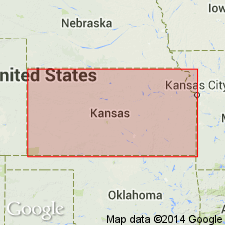
- Usage in publication:
-
- Americus limestone member*
- Modifications:
-
- Overview
Summary:
Pg. 48 (fig. 17), 49, 51 (fig. 19). Americus limestone. Basal member of Foraker limestone. Underlies Hughes Creek shale member; overlies shale member of Hamlin shale. Commonly two limestone beds separated by shale. Thickness ranges from 6 to 22 feet. Age is Early Permian (Wolfcampian).
Source: US geologic names lexicon (USGS Bull. 1200, p. 77).
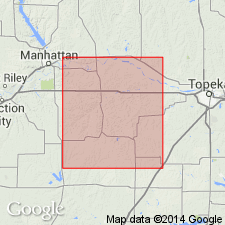
- Usage in publication:
-
- Americus limestone member*
- Modifications:
-
- Revised
- Areal extent
- AAPG geologic province:
-
- Forest City basin
Summary:
Pg. 14 (table 2), 53-56. Americus limestone member of Foraker limestone of Council Grove group. Described in Wabaunsee County, eastern Kansas. Limestone formerly called Houchen Creek south of Pottawatomie County does not correlate with type section in Nebraska, but coalesces with Americus limestone member in Wabaunsee County. This limestone has distinctive type of algae in lower part of Americus that can be traced north into Pottawatomie and Jackson Counties. Americus formerly consisted of one or two beds of limestone 12 or more inches thick in lower part, 4 to 8 feet of gray fossiliferous shale in middle part, and bed of gray limestone 18 or more inches thick in upper part. In this report, upper contact of Americus is restricted to top of lower of one or two beds of limestone. This places upper bed of limestone, which is absent in some places, and beds of shale in Hughes Creek shale member. Lower part of Americus is redefined to include algal bed heretofore referred to as Houchen Creek limestone in Chase County (Moore, Jewett, and O'Connor, 1951, Kansas Geol. Survey, v. 11, pt. 1) and in Lyon County (O'Connor, 1953, Kansas Geol. Survey, v. 12, pt. 1). In southern part of Wabaunsee County, Americus now consists of three beds of limestone separated by two beds of shale, but northward lower shale bed pinches out and lower bed of limestone coalesces with, and becomes part of, middle bed of limestone in northern part of county. Shale that lies above algal limestone was called Oaks shale member in Chase County (Moore, Jewett, and O'Connor, 1951) and in Lyon County (O'Connor, 1953). In Wabaunsee County, this is lower shale bed of Americus. Underlies Hughes Creek shale member; overlies Hamlin shale member of Janesville shale. Age is Permian.
Source: US geologic names lexicon (USGS Bull. 1200, p. 77).
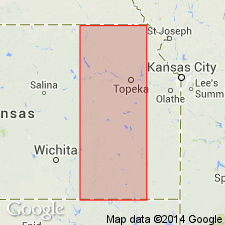
- Usage in publication:
-
- Americus limestone member*
- Modifications:
-
- Areal extent
- Biostratigraphic dating
- AAPG geologic province:
-
- Forest City basin
- Nemaha anticline
- Cherokee basin
Summary:
Pg. 3 (fig. 1), 30-33, pl. 5. Americus limestone member of Foraker limestone of Council Grove group, following Mudge and Burton (1959, p. 53-54). Subdivided into 5 units (ascending): (1) gray limestone containing stromatolite COLLENIA, formerly correlated with Houchen Creek limestone bed; (2) thin-bedded, gray fissile shale; (3) gray to light-gray limestone; (4) tan to gray, clayey to silty shale; (5) gray to light-gray limestone, generally finer grained than unit 3. Unit 1 coalesces with unit 3 from northern Wabaunsee to northern Pottawatomie County. Unit 2 pinches out in east-central Wabaunsee County. Unit 3 coalesces with unit 5 in parts of Lyon and northern Greenwood Counties. Overlies distinctive calcarenite bed in Hamlin shale member of Janesville shale; underlies Hughes Creek shale member of Foraker limestone. Distribution of fossils collected from the Americus is given in table 1 (sheet 1). Fossils include: fusulinids, coelenterates, echinoderms, bryozoans, brachiopods, pelecypods, gastropods, algae, shark. Paleontology section provides detailed discussions of species (p. 55-97). Age is Early Permian. Report includes measured sections, correlation diagrams, fossil distribution charts. [Report submitted for publication before release of 1961 ACSN code, recommending capitalization of formal names.]
Source: Publication.
For more information, please contact Nancy Stamm, Geologic Names Committee Secretary.
Asterisk (*) indicates published by U.S. Geological Survey authors.
"No current usage" (†) implies that a name has been abandoned or has fallen into disuse. Former usage and, if known, replacement name given in parentheses ( ).
Slash (/) indicates name conflicts with nomenclatural guidelines (CSN, 1933; ACSN, 1961, 1970; NACSN, 1983, 2005, 2021). May be explained within brackets ([ ]).

